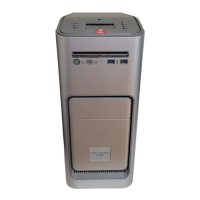REPLACING PARTS 75
TO REPLACE THE POWER SUPPLY
1 Support the power supply inside the chassis and align the mounting holes.
2 Attach the power supply to the chassis with the five screws that you removed earlier
(see Figure 28 on page 74).
If you are installing a new power supply, make sure to use the screws that came with it
to attach the new power supply to the chassis.
3 Connect the 4-pin CPU power cable to motherboard connector J18 (for connector locations,
see Figure 23 on page 57).
4 Connect the 24-pin motherboard power cable to motherboard connector ATX24P_1.
5 Connect the power and data combination cable to the DVD drive.
6 Install the ferrite around the hard disk drive power cable.
Use the ferrite that you removed earlier. Place the ferrite around the cable near the connector
and snap the edges of the ferrite closed.
7 Connect the power cable to the hard disk drive.
Connect the thin, black SATA power cable connector to the hard disk drive. Do not connect
the white, 4-pin power cable connector. Connecting both types of power cables will damage
the hard disk drive.
8 Secure the loose section of the power cable to the chassis support beam with a tie-wrap.
9 Reassemble the E-43A and verify its functionality (see page 86).
Hard disk drive
The factory-installed hard disk drive is formatted and loaded with system software, network
drivers, and printer fonts. The hard disk drive is also used to store spooled print jobs.
Available space on the hard disk drive is displayed in Command WorkStation.
If you replace the hard disk drive with a new one, you must install system software as
described on page 92. (Spare hard disk drives are not shipped with preinstalled system
software.)
Do not replace the hard disk drive and the motherboard at the same time. Doing so in the
wrong order, without updating the system (see page 59), will cause the system to malfunction.
It is unlikely that both the hard disk drive and the motherboard are defective. Avoid replacing
both to solve one problem. If troubleshooting strategies (such as checking cables and
connections; see page 99) do not solve the problem, and you suspect either the hard disk drive
or the motherboard is at fault, use the following order to troubleshoot: replace the hard disk
drive, install system software, and then check to see if the problem persists. If it does, perform
other procedures, such as replacing the motherboard (see page 59).

